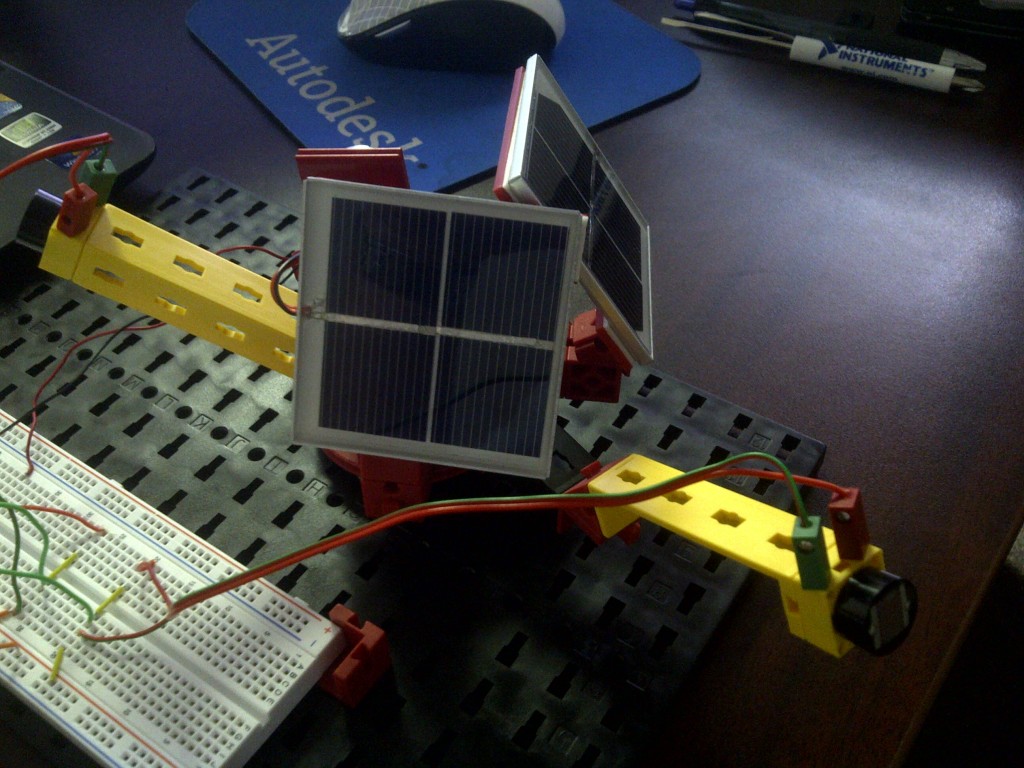With the newest Specialist High Skills Major blossoming in Ontario, many teachers are looking for teaching material to guide their students in a comprehensive, interesting, and fun way. Energy may sound simple enough, but it is tools that allow self discovery and a fundamental understanding of Energy concepts that will allow students to excel in their chosen career path.
National Instruments Hardware and Software are tools that offer just such an experience. I have recently utilized National Instruments LabVIEW software combined with the NI myDAQ to design, build, and operate a fully functional Solar Tracking Station.
I was able to use hardware from the Fischertechnik Oeco Tech Renewable Energies Kit to construct the Solar Array, complete with DC Motor. The solar tracker is a part of this kit, and comes with graphical instructions for assembly and wiring. With this, I was able to add two Light Sensors and design a simple system for control using LabVIEW.
LabVIEW is a graphical programming environment used engineers and scientists to develop measurement, test, control, and automation systems. This software will soon be released as LabVIEW Education Edition, designed specifically for teachers and students. LabVIEW was used in this project to read the data inputted from the light sensors to control the position of the solar panels so that they were positioned towards the strongest light source. In this case, two sensors pointed in different directions, one in the same direction as the panels. The program moved this sensor into the strongest light position.
In LabVIEW there already exists VIS , or Virtual Instruments, for common sensors, inputs, and outputs. This combined with the DAQ Assist allows for an easy programming experience with a low learning curve. I have included a picture of some of the interface for my program from LabVIEW.
Interfacing with the NI myDAQ offered a very easy experience as well. This piece of hardware made a complex wiring operation relatively simple with its Analog and Digital I/Os and its power source. LabVIEW collects the data from the myDAQ directly and can interpret data and determine the control, constant, or indicator required for the user to use the data or display it with the Create Tool. In my case, the light sensors were connected to the myDAQ AI (+-10V) ai0 and ai1. With the inputs set, it was easy to determine where my sensors were, what data was being produced, and what I could do with it. If you are unsure of what your data can be used for, then the DAQ Assist in LabVIEW will help you to interpret it yourself and determine what is required simply by playing with types of sensors, graphical outputs, and the Create Tool in LabVIEW.
My finished product was not powered by the sun, but it could interpret data from sensors to drive a motor in order to place two solar panels in the correct position to collect energy from the sun. Here is the finished product.
In Ontario’s Energy Specialist High Skills Major, Renewable forms of Energy are very important for the students to learn. If these forms of Energy production are not main stream by the time these students graduate, then they will be by mid career for most High School students today.
Solar Energy is a principle that is easy to teach and easy for students today to understand. However, unless the students are able to create these systems and produce this power by themselves in an environment of self discovery then the process will be boring and the results will be mediocre. With National Instruments tools like LabVIEW it is easy for the students to enjoy building energy systems while at the same time learning key concepts.
National Instruments also offers Certification Programs and Courses for those interested in professional certification. The NI Certified LabVIEW Associate Developer (CLAD) is an entry level LabVIEW Certification that could be used in the Energy SHSM Program.
Ontario Grades 11-12 Curriculum courses can be run with National Instruments and Fischertechnik products to enhance the concepts learned and to combine Energy Sector specific principles with the basics of mechanical design and assembly. TMJ3C and its hands on learning concept is an ideal course for robotics, control systems, and power production. TDJ3M would allow the students to design their own power production systems from basic mechanical assembly to circuit design, wiring, and power production principles. SCH4U and its focus on electrochemistry could also be used in the Energy SHSM to prepare students and develop core concepts. With National Instruments LabVIEW Education Edition and K12 Labs full Curriculum resources, projects, and designs, it is now an easy task to teach high level concepts to our students at the Secondary Level.
If you would like more information on the tools available for teaching Energy Concepts to your students please contact us here at Studica and we will be happy to show you the multitude of approaches possible with National Instruments and Fischertechnik.
Author: Matthew Colbeck
Share this Post



